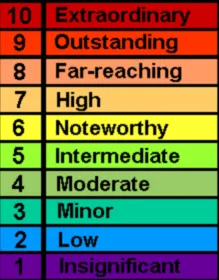This article addresses the best way to incentivise curators without encouraging the production of autovote bots

There is a lot of debate going on at the moment regarding Steemit curator rewards. I myself have added my voice in the comment section to a couple of posts by dantheman A New Approach To Content Reward Allocation and A New Approach To Content Reward Allocation Part 2 but I felt that the point was being missed sufficiently to warrant me making a post addressing the issue.
Steemit rewards curators, because curators add value to the Steemit platform. However we seem to have lost sight as to what a curator actually is. This has caused us to miss the point of what value actually is and have forgotten that not all value added is the same. Once we define exactly the different levels of contribution, then how we share the rewards becomes more obvious.
Curator Value Scale

Voter Value: A voters value is not to be completely dismissed, a collection of votes for a Steemit post, will keep that post high on the Steemit feed, making it easier for a freshly logged in user to spot the article.
However, the vote on its own has a very limited value, it can hardly be said that a post with one vote, has had its value raised significantly. This; like an ant or termite colony, is clearly a case of the whole being much greater than the sum of any of its parts.
Commentator Value:
Comments raise the value of posts in a couple of ways. Firstly they work in much the same way votes do, in that articles with fresh comments on them, will figure high in the Steemit feed.
Secondly comments are contributions to the article's discourse, a comment may start a debate, which in turn makes the post more popular.
It is not just about popularity of course, a good article with a comment section packed full of insightful arguments and counter-arguments, adds to the richness and general quality of the article.
Last and by no means least, comments raise the value of the original post, by contributing to the SEO.
For example, if you comment on an article about dirt bikes and you add a comment that gives more information about, speed, style and cost. Then you have contributed to the SEO in a positive way, when the Google spiders crawl over the article, they will see relevant comments which will cause them to rank it higher.
Helping Steemit articles to rank higher on Google is clearly adding value, as that may bring new users to the platform.
So we can see that a commentator can add four levels of value as opposed to the voter's one.
Link Commentator Value
Somebody who adds relevant links to a post in the comment section is raising the value even higher.
This is because Google and other search engines (they do exist!) use relevancy algorithms and they class both inbound and outbound links as a high indicator of relevancy.
So for instance, going back to our article on dirt bikes, if the article is about where to get the most kick ass rims and forks. Any links in the comment section leading to shops, or other content relating to dirt bikes, will rank the article higher.
Apart from the SEO. there is the added value given to the reader, as a good link can help further the discussion.
Sharer Value
Somebody who shares an article on another social platform clearly has value; that person is spreading the word and giving more people the chance to access the site. The more Steemit articles are shared on rival platforms the more chance, the article has of going viral.
Sharing creates a positive feedback loop, whereby the more visitors that discover Steemit through shared articles, the higher the search engine rank, meaning more people are able to discover Steemit.
The Solution
OK, so we know that a voter has a value and we know that a sharer has more value. In much the same way the richter scale, which measures seismic activity, is split up by factors of 10, so too should our Curator Value Scale.
So a commentator who replies to posts and post comments isn't just twice as valuable as a voter, but 10 times more. This distinction, though somewhat arbitary, is important to make.
Imagine you were on Facebook and all you did for 2 years was to like posts. It would be fair to say that you were receiving more value than you were giving. At the end of that 2 years if Facebook gave you $20 for logging in every day and evening and liking on average 20 posts per day, you'd probably say something along the lines of; "wow, I didn't expect that!" and you'd be happy.
If however you had spent hours per day on the system and you had liked, commented on, linked to and from and shared posts, then $20 wouldn't seem so great.
So the rewards are simple, first of all there are no prizes for voting up a soon-to-be-popular article and there are no prizes for acting first.
Then we have as follows:
Vote = n
Comment = n x 10
Link Comment = n x 10x10
Sharer = n x 10x10x10
This is a true reflection of value, a sharer who reposts an article to 15,000 Twitter followers, should get 1000 times more of a reward than a voter. Because their action has the potential to spread the content to tens of thousands more people than a voter.
Understanding The Nature Of Incentive
In an ecosystem like Facebook, where nobody is rewarded for liking a post, likes are given out as tokens of appreciation.
By introducing a cash incentive for voting, we change the nature of the vote. Now we have a situation where people aren't voting to give a token of appreciation, they are voting to financially reward themselves.
If we further skew the voting rewards and incentivise for predicting the future popularity of an article. Then all we are doing is encouraging the user to find popular content producers to give their votes to.
So now the problem is clearly defined, we want to reward users for doing what they do on Facebook. But rather like a quantum observation; rewarding users for voting changes the very nature of the act.
However unlike the uncertainty principle of quantum mechanics, there is a workaround.
Rewards should be disbursed according to levels of engagement and not engagement in isolation. Therefore a voter who votes in isolation should be given little or no reward.
However somebody who votes and posts a relevant link to a popular site, which is clicked by other users and voted up. They should get a bigger reward. Any rewards should be pegged to the amount of users who find the link useful.
A user who votes, links and comments is given an even greater, sliding-scale rewards.
A user who votes, links, comments and shares is given the highest sliding-scale rewards possible.
If we treat contribution in this way, then a user is incentivised to find content they can meaningfully engage with. As they will only comment and link on content they can understand and enjoy. Social mechanics mean people will only share things that they truly think is worth sharing.
Conclusion
Not all contribution is equal and therefore, rewards for contribution should be similarly unequal.
Sharing is the highest form of contribution, by recognising this fact and rewarding it accordingly, will encourage the sharing of Steemit articles on multiple social media sites.
Any sliding-scale reward system should be encouraged because at worst it will discourage spammers to produce auto voting bots. At best it will encourage the same people to create automatic software that will actually enhance the system, by intelligent engagement and sharing.
CryptoGee